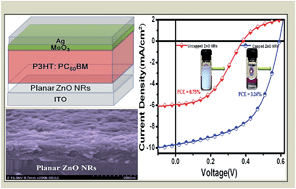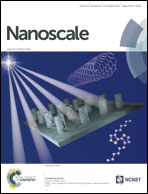Development of highly transparent seedless ZnO nanorods engineered for inverted polymer solar cells†
Abstract
This work reports on inverted polymer solar cells (IPSCs) based on highly transparent (>95%), hydrophobic, seedless ZnO nanorods (NRs) as cathode buffers with extremely enhanced electrical characteristics. The transparent NR suspension with stability for more than a year is achieved by adding a small amount of 2-(2-methoxyethoxy) acetic acid (MEA). The ability of the stable nanorod suspension to easily spin-coat is certainly an advance to the fabrication of films over large areas and to replace the conventional seeding method to grow one-dimensional nanostructures for use in optoelectronic devices. We observe a strong correlation between the photovoltaic performance and the transparency of ZnO NRs. IPSCs using poly-3-hexylthiophene (P3HT) and [6,6]-phenyl C60 butyric acid methyl ester (PCBM) mixtures in the active layer and transparent (MEA-capped) ZnO NRs as cathode buffers exhibit a power conversion efficiency of 3.24% under simulated AM 1.5G, 100 mW cm−2 illumination.


 Please wait while we load your content...
Please wait while we load your content...